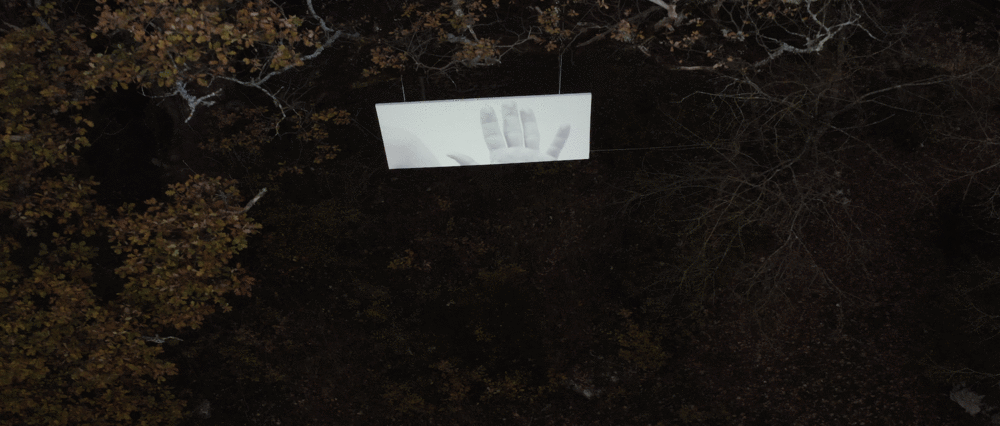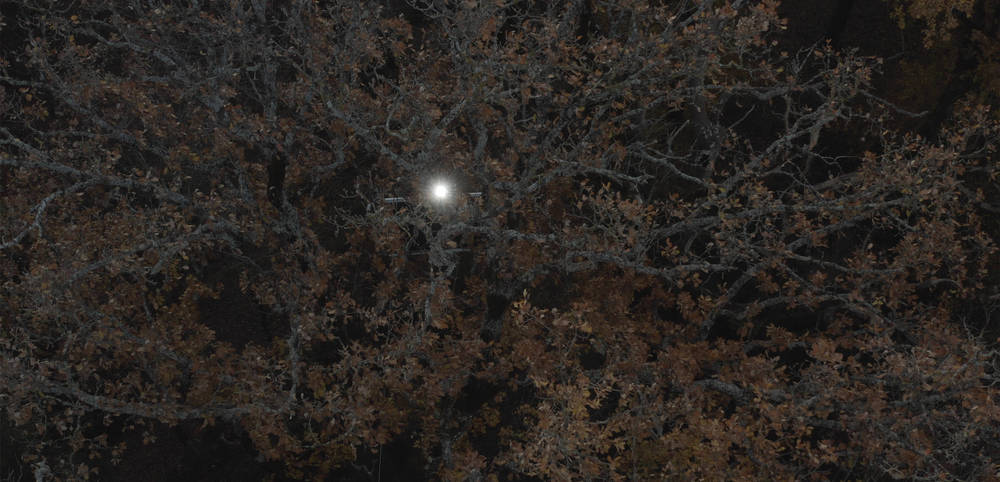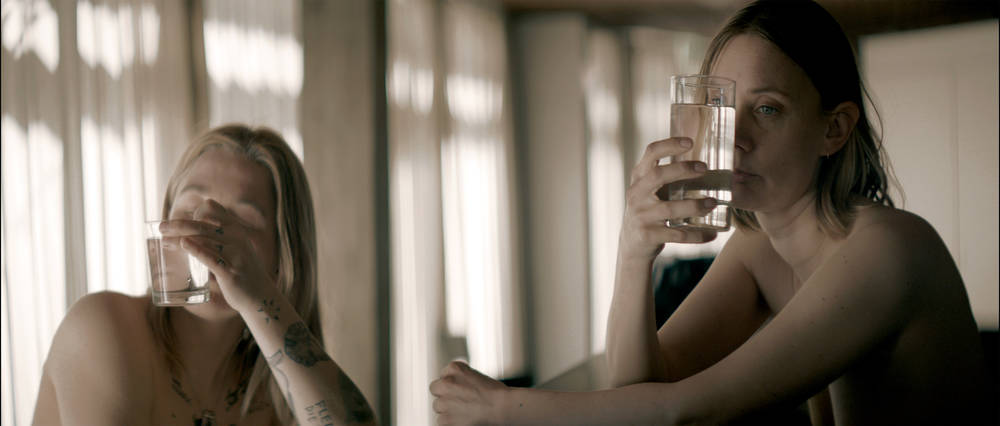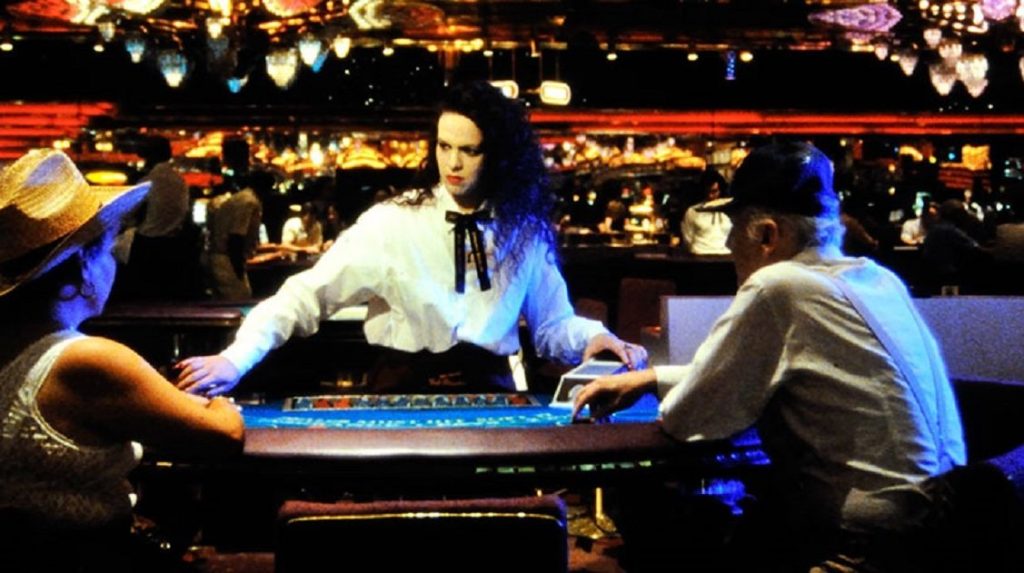Solitude, subjective feelings, ineffability, desire, a poetic approach to the world and our surroundings – these themes were typical for the Romantic epoch and are also to be discerned in Christin Berg’s carefully filmed images. However, she combines them with impressions from the present day, and their current status prompts great uncertainty.
From a bird’s eye perspective, the camera moves sedately in the early light of dawn toward the crown of a tree that bears almost no leaves any longer. We hear woodwind instruments producing pulsating staccato notes, while the camera slowly descends to the ground and gives us a view of a canvas hanging from the tree. We move ever closer to it: It shows black-&-white close-ups of parts of the human body – a hand, a foot, a neck with a necklace. The woodwind instruments become more forceful, combining ever more to form an oscillating rhythm. The canvas hanging lonely in the tree seems then to swallow the camera and catapult it to another place. The camera is up flying once again, this time during daylight, it goes flying over a forest world that runs along between mountains and valleys. What seems at first sight to be untouched nature is, however, anything but that: Somewhere a fire seems to be burning and the camera moves slowly toward it; elsewhere trees are being felled while bright sunlight here and there diffusely penetrates the light layer of smog.

Between past and present, dystopia and utopia
In what follows Christin Berg’s “Beyond The Now” (2022) leads from the images of nature into the sphere of human life or, to be more precise, from the countryside around the Italian community of Olevano Romano to the bar of the Akademie der Künste in Berlin. While at the end of the 18th century, Romantic artists drew their inspiration from the idyllic provinces of Italy, many might feel the lifeworld of the Berlin Akademie der Künste provides the antithesis to this – even though in its day the architecture itself sought consciously to incorporate the building’s green surroundings such as Berlin’s Tiergarten. Inside, the camera now focuses on the human body in its urban surroundings: A child races through the room, then a woman gets up, as if for the first time in her life, from the floor behind the bar. Two women with naked torsos cautiously explore each other’s bodies. A fourth woman then narrates a dreamlike story the content of which loops back to the beginning of “Beyond The Now”. Solitude, subjective feeling, desire, a poetic approach to the world are all themes typical of the Romantic period that we encounter in Christin Berg’s carefully staged filmic images – projected in the here-and-now with all of its great uncertainties.


Other film works by Berg move between the twin poles of past and present, dystopia and utopia: Her three-channel installation “Fire on Air” (2021) juxtaposes three separate and self-contained about women in contrasting landscapes in Iceland, Germany, and Portugal to one another and resulted from her in-depth study of utopian literature. Symbols of the past that are in the process of disappearing pop up in “From now on Silence” (2020) in the guise of old architecture that is about to be demolished, while in “I Am Going” (2021) a dystopian narrative evolves around architectural transformations in the urban space.
A life between the promise of happiness and everyday misery
As the second film, Christin Berg has chosen “Queen of Diamonds” (1991) by US filmmaker Nina Menkes. The film presents scenes from the life of Firdaus, a Blackjack dealer in Las Vegas played by Nina Menke’s sister Tina. We see the woman at work, we see her caring for an old man on his deathbed, and we see her in other everyday scenes
.
The camera is largely immobile and in its long sequences the almost silent film captures a life between the promise of happiness and everyday misery. By means of an expressive mise-en-scène into which Menkes repeatedly embeds seemingly Surrealist elements, what we see increasingly assumes threatening proportions: For minutes at a time, the camera films a burning palm-tree or shows manically swaying circus elephants in the immediate proximity of a fatal car crash. The contrast between the paradise promised and the real lifeworld is already intimated by the choice of the protagonist’s first name, as Firdaus in Arabic quite literally means the “highest level of Paradise”, and the young woman’s everyday life seems a very far remove from it. In “Queen of Diamonds”, the dystopian collapse of Nevada’s oasis of happiness in the middle of the desert is conveyed almost exclusively by the highly expressive composition of the images that result in what we see presenting a narrative all of its own, such that the film material does not get reduced to the simple visualization of an unequivocal spoken narration.

Nina Menkes: Queen of Diamonds, 1991, Film still, Image via potts.la









